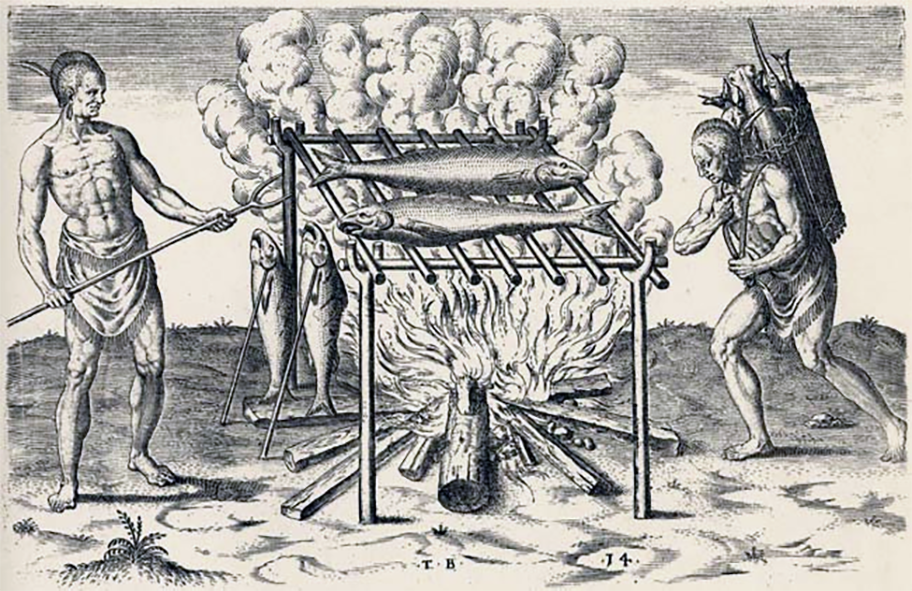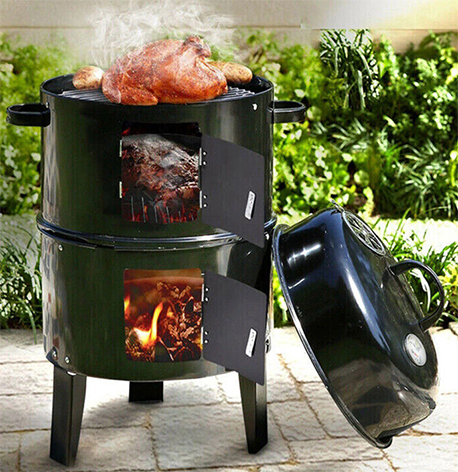FabulousFusionFood's Barbecue Recipes Home Page
 Traditional Arawak barabicu, cooking fish suspended over flame.
Traditional Arawak barabicu, cooking fish suspended over flame.
Welcome to FabulousFusionFood's Barbecue Recipes Page — Barbecue or barbeque (often shortened to BBQ in the UK, US, and Canada; barbie or barby in Australia and New Zealand; and braai in South Africa), is a term used with significant regional and national variations to describe various cooking methods that employ live fire and smoke to cook the food. The term is also generally applied to the devices associated with those methods, the broader cuisines that these methods produce, and the meals or gatherings at which this style of food is cooked and served. The cooking methods associated with barbecuing vary significantly but most involve outdoor cooking. It is typically a method of preparing meat over hot charcoal so that the meat is simultaneously quickly heated by the coals and smoked by them so that the food acquires a distinctive smoky flavour.
The various regional variations of barbecue can be broadly categorised into those methods which use direct and those which use indirect heating.[1] Indirect barbecues are associated with North American cuisine, in which meat is heated by roasting or smoking over wood or charcoal.[2] These methods of barbecue involve cooking using smoke at low temperatures and long cooking times, for several hours. Elsewhere, barbecuing more commonly refers to the more direct application of heat, grilling of food over hot coals or a gas fire. This technique is usually done over direct, dry heat or a hot fire for a few minutes. Within these broader categorisations are further national and regional differences.
Though the cooking technique is used world-wide, the term barbecue is most typically employed in the United States, Canada, the United Kingdom, France, New Zealand and Australia. However, it is not the typical cooking method in any of these countries, rather being an outdoor cooking method used during special occasions.
In sub-Saharan Africa, where it is the commonest means of cooking red meats (apart from cooking in stews) it is typically referred to as ‘roasting’ and in South Africa the barbecue is known by its Afrikaans name of ‘braai’.
Barbecuing:
Barbecue is usually done in an outdoor environment by cooking and smoking the meat over wood or charcoal. Restaurant barbecue may be cooked in large brick or metal ovens specially designed for that purpose. The term ‘barbecue’ is used both as a verb and a noun. As a verb it refers to the act of cooking food on a barbecue. As a noun, it can refer to the cooking apparatus itself or to the social situation in which food is cooked on a barbecue.It should be noted that in British English, the term ‘barbecuing’ refers to cooking food quickly by placing it directly over high heat and grilling refers to cooking under a direct source of heat (which in North America is known as broiling). In contrast, in the USA the term grilling refers to cooking food quickly over high heat and barbecuing refers (in the main) to a slower cooking process using indirect heat and/or hot smoke. As a result, a typical American home grill (the equivalent of the British barbecue) has food cooked on a grate directly over hot charcoal, whilst in an American barbecue the coals are dispersed to the sides or at significant distance from the grate. In South Africa wood is the main cooking agent, though charcoal is deemed an acceptable substitute.
Origin of the Term ‘Barbecue’
Of course, cooking meat over a wood fire is old as humanity’s first discovery that putting meat in the embers of a fire to char improved its flavour, texture and digestibility. However, the term barbecue seems to appear in the English language during the 17th century.The original terms seems to have come from the word barbecue derived from the language of the Taíno people of the Caribbean and the Timucua of Florida. It seems to have entered European languages (initially via Spanish) as the form barbacoa, literally meaning ‘sacred fire pit’. Which is a classic form of pit cooking rather than being cooked over a fire. The word migrated to French from the Portuguese and to English from the French. The first recorded usage in English was recorded in the published writings of John Lederer following his travels in the American southeast in 1672 and it appears in its proper modern form of ‘barbecue’. However, the most well known early usage is by the British buccaneer William Dampier in 1697. By the mid 18th century the word had become more commonplace and Samuel Johnson defines it in his 1756 dictionary as:
To Barbecue – a term for dressing a whole hog' (attestation to Pope)
'Barbecue – a hog dressed whole'
This agrees with modern usage of ‘barbecue’ in the southeastern USA, where the noun ‘barbecue’ typically is used in the context of cooking cuts of pork.
In Australia the term is used more broadly for any meat and fish and in Britain the term can refer to any foods (vegetables as well as meat, fish and seafood) cooked on a barbecue over hot coals.
Barbecue Cooking Methods
Barbecuing is not just a process of slapping food on a grill over hot coals and cooking them. Several food preparation methods can be employed and these are detailed below. All these techniques are covered in the various recipes in this book.Barbecuing/Grilling
 Cooking in a kettle barbecue outdoors.This is the classic method of placing the food to be cooked over hot coals so that they are cooked directly by the heat of the coals.
The distinction between smoking and grilling/barbecuing is the heat level and the intensity of the radiant heat; so that the process of smoking is often referred to as ‘low and slow’. Additionally, during grilling/barbecuing, the meat is exposed to the open air for the majority of the time. During smoking, the barbecue lid or smoker door is closed, causing a thick, dense cloud of smoke to envelop the meat. However, the smoke must be able to move freely around the meat and out of the top of the apparatus quickly; otherwise, foul-tasting creosote will build up on the meat, giving it a bitter flavour. As a result the smoke holes in the top or side of the lid must be open. Outside of the US, this is the most common technique when cooking classic barbecue foods, although some variants of grilling require direct, but moderate heat.
Cooking in a kettle barbecue outdoors.This is the classic method of placing the food to be cooked over hot coals so that they are cooked directly by the heat of the coals.
The distinction between smoking and grilling/barbecuing is the heat level and the intensity of the radiant heat; so that the process of smoking is often referred to as ‘low and slow’. Additionally, during grilling/barbecuing, the meat is exposed to the open air for the majority of the time. During smoking, the barbecue lid or smoker door is closed, causing a thick, dense cloud of smoke to envelop the meat. However, the smoke must be able to move freely around the meat and out of the top of the apparatus quickly; otherwise, foul-tasting creosote will build up on the meat, giving it a bitter flavour. As a result the smoke holes in the top or side of the lid must be open. Outside of the US, this is the most common technique when cooking classic barbecue foods, although some variants of grilling require direct, but moderate heat.
 Cooking in a kettle barbecue outdoors.
Cooking in a kettle barbecue outdoors.Smoking
 Cooking in a barbecue smoker outdoors.This is the method of cooking food (usually meat) on a barbecue where wood chips soaked in water have been added to the hot coals to create smoke. The food is cooked in the heat of the smoke and is flavoured by the smoke itself. This is the more typical usage of 'barbecue' in the USA.
Cooking in a barbecue smoker outdoors.This is the method of cooking food (usually meat) on a barbecue where wood chips soaked in water have been added to the hot coals to create smoke. The food is cooked in the heat of the smoke and is flavoured by the smoke itself. This is the more typical usage of 'barbecue' in the USA.
This is typically a slower, lower heat method of cooking than grilling and the food is often isolated from the coals by baffles or other chambers.
 Cooking in a barbecue smoker outdoors.
Cooking in a barbecue smoker outdoors.This is typically a slower, lower heat method of cooking than grilling and the food is often isolated from the coals by baffles or other chambers.
 Fish steaks cooked en papillote on a barbecue.
Fish steaks cooked en papillote on a barbecue.The term en Papillote is a French one for cooking in a parcel or packet. This is particularly useful for cooking on a barbecue as meat, fish and vegetables can be wrapped in a foil parcel with seasonings and liquid before being placed directly on the barbecue. This ensures that all the flavours are kept inside the parcel and because the food is steamed it comes out very tender and succulent. This is a technique that is particularly commonly used for preparing fish.
Typically this is done in a masonry or clay oven, where the burning wood or charcoal is set at the back or sides of the oven and the food to be cooked is set near the front. This is the classic method for cooking pizzas and was the method of baking bread for centuries. Such ovens can also be used to cook pies and casseroles. Traditional French barbecues are a blend of a masonry oven and an open-topped barbecue.
Frying
Australian-style barbecues tend to have a metal plate on them that can be used to directly fry meat on. This is particularly useful for frying burgers and steaks and can also be used for heating shellfish. You can get the same effect by placing a baking tray or metal sheet on a barbecue grid and allowing it to heat up before cooking.
Stewing and Braising
Because a barbecue is a source of heat, you can use it for frying, boiling and braising, as you would any other heat source. It’s particularly suitable for cooking with a wok, so you can prepare stir-fries, stews and glazes directly on the barbecue. A Spanish-style paella is the classic example of a dish like this prepared outside on the barbecue.
The alphabetical list of all the Barbecue recipes on this site follows, (limited to 100 recipes per page). There are 376 recipes in total:
Page 1 of 4
Page 1 of 4